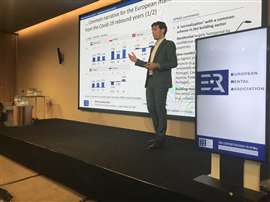What the KMPG survey tells us about the rental industry in Europe
21 May 2024
 Martin Seban, director of KPMG at the ERA Convention in Lisbon
Martin Seban, director of KPMG at the ERA Convention in Lisbon
Record numbers attended the ERA Convention in Lisbon last week, with nearly 390 key figures in the equipment rental industry gathering to discuss the sector’s future.
The Convention featured a range of speakers who highlighted critical issues impacting the industry’s future, including AI, the energy transition, and decarbonization.
One notable speaker, Martin Seban, director of KPMG, presented an overview of the rental industry’s current landscape and future outlook in a keynote session.
Here are the key findings:
Softer demand, but residual inflation fuels optimism
Seban provided an updated forecast on individual European markets, showing mixed results.
In the UK, 2024 growth has been downgraded by 1.2% to 1.5%, and 2025 growth is expected to drop by 2% to 2.5%.
Germany is now predicted to see 3% growth in 2025, down by 1.4% from earlier forecasts.
Spain and Italy have maintained steady investment levels due to EU financial support, with projected growth of 5.5% and 3.5% respectively next year.
The Nordic region faces the biggest downgrades for 2025, with Norway down by 5.1%, Sweden by 2%, and Finland by 2.8%.
Modest GDP expansion in Europe
Seban noted that as the rental industry diversifies and targets new end markets, it becomes more connected to the global economy. He opened his presentation with a sobering statistic.
After a post-Covid GDP growth of 6.2% in the Eurozone in 2021, the past two years saw more modest growth of 3.5% and 0.5% respectively.
The outlook for the next 18 months is also uncertain, with forecasted growth of 1.3% for 2024 and 1.5% for 2025.
Seban said, “Since 2023, we’ve seen a real slowdown in activity for various reasons, including inflation rates, which prompt central banks to raise interest rates, slowing the economy.”
Despite these challenges, Seban highlighted some positives: “The NextGen EU program, which allocates up to €800 billion by 2027, is a significant opportunity. Based on the criteria, countries like Spain and Italy could see up to a 10% GDP boost from EU financial support, whereas Germany and France might see less than 2%.”
Impact on Construction
The construction industry shows a similar trend. After a 5.3% recovery in 2021 and a 2.7% increase in 2022, this year is predicted to see a 2.1% decrease. Modest growth of 1.5% is expected by the end of 2025.
Concerns are particularly acute in the residential construction market, which accounts for an estimated 49% of construction activity in Europe.
KPMG has revised its outlook downward due to an “accentuated contraction of the new residential market,” leading to the lowest confidence in the sector since the pandemic began.
Impact on the Equipment Rental Market
As of 2023, KPMG estimates that 65% of the equipment rental industry in Europe is linked to construction. The slowdown in residential construction, declining customer confidence, and rising interest rates are thus significantly impacting the rental industry.
Of this figure, 35% is either residential or non-residential construction (with civil engineering comprising the remaining 30%).
Seban stated, “Residential construction, in particular, is a significant portion of the business alongside non-residential, both suffering greatly and accounting for the major shifts in revenue generation across Europe. The impact varies by country due to market maturity and diversification, as well as the size of the construction segment.”
STAY CONNECTED



Receive the information you need when you need it through our world-leading magazines, newsletters and daily briefings.
CONNECT WITH THE TEAM







